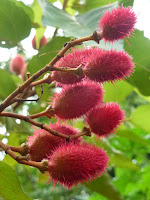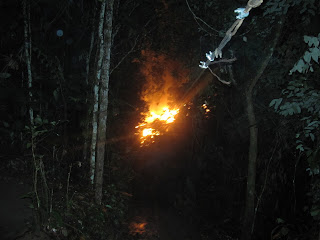Dragoman restarted their trips to Colombia this year; we are on only their third trip, and they have already changed the itinerary once to deal with practical and safety issues, so this leg may be a little more unpredictable at times. Whether coming to Colombia proves to be a wise decision only time will tell, but it feels like we should be OK if we stick to the advice not to travel at night and take care in the towns.
We crossed the border with no problems, and set off up to Ipiales. The main road up was known for there being some attacks on vehicles, so now the police are out in force with regular security check points, and if you travel during the day it is generally safe. We made it to Ipiales without any problem.
 |
| wanted terrorists |
NB: Since writing this we have heard that Alfonso Cano, the farc leader was killed, so one of the other faces should have a red cross through it too!
 |
| Las Lejas |
But we did go just out of town to see a cathedral called Las Lajas. It is nestled in a valley on a bridge over a river, with a waterfall next to it. It is quite gothic looking, and is quite impressive when you look down on it from the hill. Personally, I think it looks better from a distance than it does close up, but it is worth walking down to it to see all of the of plaques on the walls. Las Lejas competes with Lourdes for being the place with the most miracles. People come to pray in the hope of being healed, and the thousands of plaques on the walls are put there by those who claim to have succeeded.
 |
| a few of the miracle plaques |
I can't say I am convinced by the idea of the miracles, but the people who visit clearly are. When I walked in to the church there was a couple walking out and she clearly had an injury to her leg. As I waited for them to pass, the man clasped my hand and said something that I didn't really understand, but seemed to be about having faith together. I just smiled at him, rather than telling him that I don't believe in all that stuff. They obviously take some hope in this pilgrimage, and if that positive attitude helps them in even a small way, who am I to knock them. But still I found it a little sad that so many people must come here and in reality, leave no better than when they arrived.
And I guess a pilgrimage only counts if it is difficult, but the hill and steps down to the church, and then back up again, were no easy if you had a walking disability. I know that I felt the strain on my knees on the way down, and they were no better on the way back up, so clearly there was no miracle for me!
Back in Ipiales it was clear there was nothing much to see, so we and Leoni thought we'd try to find a cafe with wifi. We have got so used to it being available everywhere in Argentina, Bolivia and Peru,that we just expected it to be available here too. How wrong can you be? We asked all over the place and some of them looked at us like we were crazy, it's just shook their heads. We did spot a place where people were drinking coffee and using laptops though, so we checked that out. It didn't quite feel right when we went in, and we gradually realized that we were in the campaign HQ for one of the political candidates on the upcoming election. They did offer us a coffee but we felt it best to beat a hasty retreat before we were asked to hand out leaflets or something. Colombia is not the safest place to get involved in politics!
We found a place with Internet and they directed us to a few streets away, but when we go there there was nothing that looked right. We tried in the most likely looking cafe, and they were very helpful and led us upstairs t an area by the kitchen and turned on their own wifi for us. It didn't work as the signal wasn't strong enough to reach us, but it was good of them to try, so we had a drink there before going to just a normal Internet place.
The meal in the evening was a somewhat chaotic event, with some old arriving ages after everything else, wrong and forgotten orders and general confusion all round. A quick reminder that we are in South America after all. Part way through the meal, we met a couple of guys from another Dragoman truck that were on their way down from Cartagena. They had arrived late because they'd run out of petrol. I'm sure that Izzie and TJ would never do that!
I can't say that we were sad to be moving on the next day.





























